The Indian Head cent was produced by the United States Bureau of the mint. Also known as the Indian Head Penny, the coin was minted from 1859-1909. James Barton Longacre who was the Chief Engraver at the Philadelphia mint was responsible for its design.
Indian Head coins have always been a favourite for collectors right from the century that it was produced. Being the first of its kind, a copper-nickel alloy, it is sure to get any collector’s interest.
The display of the rich cultural heritage of the native Americans with Lady Liberty’s portrait on a headdress is also very beautiful to look at and makes it a wonderful piece of art.
This coin is not considered a rare coin because it was minted in a large amount
With the flood of information online concerning this coin, we know how tough it will be for you to ascertain the value of this coin. We’ve brought you well-curated and straight-to-the-point details to answer your question.”How much is a 1906 Indian Head cent worth?”
1906 Indian Head Cent
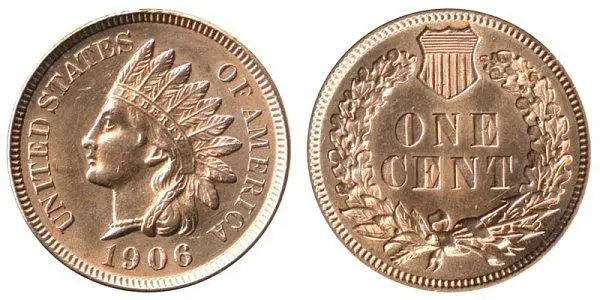
The 1906 Indian Head Penny is currently valued at $3.30 in average condition and can be worth $42 to $63 or more in Uncirculated (MS+) Mint Condition. Proof Coins can be worth up to $160 or more.
You should be careful to inspect your coin circumspectly as you might find variations and errors that will ultimately affect the price of your coins positively. We have discussed in more detail the factors that can affect the value of your coin in the Value section.
This penny is made of 95% Copper and 5% Tin And Zinc. Owing to the abundance of gold during the California Gold Rush, there was inflation that resulted in an upsurge in the price of copper. To buffer this, the mint looked for alternative means to reduce the cost of production of this coin.
In order to achieve this relatively lower cost of production, the size of the coin was reduced and the copper content was reduced from 100% to 88% while 12% nickel was used to substitute the rest.
This was the first time copper-nickel metal blend will be used for an American coin, because of the shiny effect this mixture had, they were called “white cents” or “Nick’s”
| Mintage | 96,020,530 |
| Metal Composition | 95% Copper – 5% Tin And Zinc |
| Mass/Weight | 3.11 grams |
| Diameter | 19 mm |
| Thickness | 1.52 mm |
| Minted At | Philadelphia |
| Mint Marks | No |
| Edge | Plain |
| Designer | James B Longacre |
1906 Indian Head Penny History
From 1793 to 1857 cents were 100% copper coins and they were about the same size with the half dollar. In 1857 because of the inflation and fluctuations in the price of copper, measures had to be taken to reduce the cost of production of cents.
The Mint resorted to reducing the size of the coin and altering the composition from 100% copper to 88% copper and 12% nickel which by the way, was the first time this copper-nickel mixture was used for an American coin. After the world war cents became very popular and were struck in large amounts even reaching up to 100 million in 1907.
Indian Head coins actually came into existence as a result of the difficulty in producing the Flying Eagle. The Flying Eagle suffered a lot of alterations because of the ongoing war and the complexities involved in the production of this design.
It was in 1858 that Mint Director James Ross Snowden finally chose the Indian Head to replace the Flying Eagle.
This replacement was made because it was really difficult to make the Flying Eagle design in the copper-nickel alloy. So James B Longacre was told to make another design. From slimmer eagles to the Head of Columbus, different designs were considered and some were presented by Longacre until finally the Indian Head was chosen.
Walter Breen suggests that Snowden chose this Indian Head and Oak wreath design because it will be easy to strike on the alloy.
Even though by the 20th century this coin was accepted nationwide, its production was permitted only at the Philadelphia mint. It was not until 1908 that the San Francisco mint started minting this coin after approval was granted in 1906. The production continued from 1908 to 1909. It was in 1909 that production of the Indian Head cents stopped and was replaced by Lincoln cents.
1906 Indian Head Penny Design
Obverse
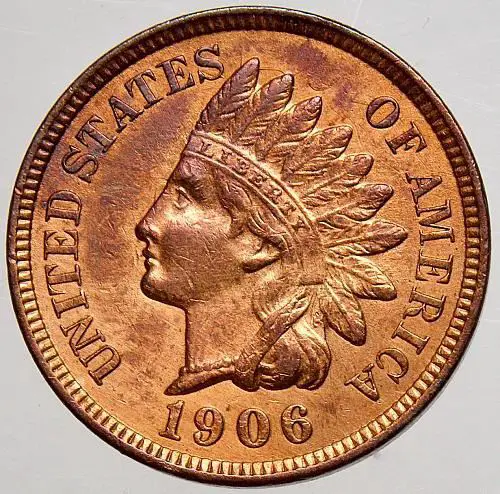
This design was done in 1858 by James B Longacre. It is a left portrait depicting Lady Liberty as a native American in full headdress, surrounded by the inscription “UNITED STATES OF AMERICA.” which spreads from the right to the left side of Lady Liberty while “1906” is beneath her head.
There is a tale surrounding the Obverse design saying that Longacre’s daughter was at the mint one day and she tried on the headdress of one of the visiting Indian Americans, so Longacre made a sketch of her and this is where the inspiration for the design came from. This story has been debunked and labelled false by Snowden, the Mint Director and he also stated that the coin design was not based on any human feature in Longacre’s family.
Reverse

Also Designed by Longacre, this particular reverse was designed in 1859 replacing that from 1858 which had a Laurel wreath and was without a shield.
This one displays the oak wreath connected by a bow with arrows inside at the bottom, while the top of the wreath is slightly separated from closing by a shield in the middle. In the centre of it all, is a large “ONE CENT” inscription signifying the denomination of the coin.
1906 Indian Head Penny Value and Chart
It was in 1906 that the Mint received permission to resume coin production of base metals at any mint, so by 1908 San Francisco mint began producing this penny. Although only a small mintage of about was made available,
The 1906 Indian Head is only available in the Philadelphia mint, thereby having no mint mark as all coins struck in this mint have no marks. The Philadelphia mint struck 96,020,530 of the 1906 Indian Head Pennies and 1725 Proof coins.
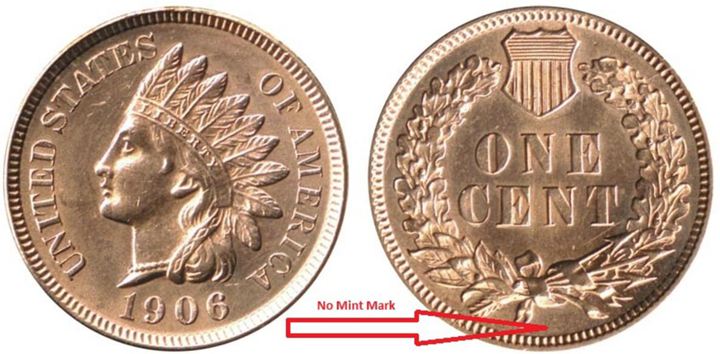
| Group | Small Cents |
| Value | 1 Cent |
| Mintage | 96,020,530 |
| Metal Composition | 95% Copper – 5% Tin and Zinc |
| Mass/Weight | 3.11 grams |
| Diameter | 19 mm |
| Thickness | 1.95 mm |
| Minted At | Philadelphia |
| Mint Marks | No mint mark |
| Edge | Plain |
| Designer | James B Longacre |
| Obverse Design | Liberty with headdress |
| Reverse Design | Oak Wreath and shield |
| Design Year (Obverse) | 1858 |
| Design Year (Reverse) | 1859 |
| 1906 Indian Head Penny Value by USA Coin Book | |
| Grade | Price |
| Good | $2.28 |
| Very Good | $3.30 |
| Fine | $5.13 |
| Very Fine | $6.64 |
| Extremely Fine | $11.00 |
| About Uncirculated (AU 50) | $23.00 |
| Uncirculated MS (60) | $42.00 |
| Brilliant Uncirculated MS (63) | $63.00 |
| Proof PR (63) | $160.00 |
| 1906 Indian Head Penny By PCGS | |
| Grade | Price |
| MS 63 | $160+ |
| MS 63+ | $200+ |
| MS 64 | $275.00 |
| MS 64+ | $325.00 |
| MS 65 | $700.00 |
| MS 65+ | $775.00 |
| MS 66 | $1900.00 |
| MS 67 | $27,600.00 |
1906 Indian Head Penny Sold At Auction
Over time, Indian Head Cents from 1906 have emerged on auctions in mint conditions. Some collectors who know the value of this coin will most likely increase in a couple of years are willing to pay top dollar for the coin at auctions.
Here are some examples of 1906 Indian Head Pennies that have sold at auction;
- 1906 1C MS67 Red PCGS Sold on Jan 9, 2014, for:$12,925.00
- 1906 1C PR67 Brown NGC Sold on Aug 12, 2010, for:$2,645.00
- 1906 1C MS66 Red PCGS Sold on Apr 25, 2021, for:$1,560.00
1906 Indian Head Penny Grading
These coins are over 100 years old and have obviously been through a lot, this does not include the Uncirculated grade.
You can use Professional grading companies to evaluate the grade of your coin. You should look closely at the following when you are trying to figure out the condition of your 1906 Indian Head penny.
- Headband
- Hair
- Eligibility of “liberty” on the headband
- Feathers on the headdress
The following are grades of coins;
Good Condition
In this condition only very little detail is remaining, everything has become smooth as all fine lines have disappeared, even the word “Liberty” is no longer visible. The date and letters are still distinct from the outer rim but are obviously worn out. This state is usually useful for its melt value. Sometimes you might notice that coins in this grade are bent or chipped.
Fine
Almost everything in this grade appears smooth,” Liberty” on the headband is faded but still visible. A “Fine” grade coin means it has spent a lot of time in circulation but still managed to survive
Extremely Fine
Coins that are graded Extremely Fine, and have experienced only a small amount of time in circulation. For this grade, slight wear can be noticed but it still has high appeal, “Liberty” is still sharp on the headband. Other details of this coin are also still sharp and distinct
Uncirculated
Since there has been no exchanging of hands for this coin, they are in top condition. The original imagery, texture, and shine of coins in this grade are preserved, there is no wear on the surface. The hairband, neck, and feather end still show original design features. You might notice some stains and surface marks
1906 Indian Head Penny Errors
The errors of this coin include clipped planchets, repunched errors, broad struck errors, and of course lamination errors. Do well to check your coins as finding genuine errors on them significantly increases the value.
Repunched Error
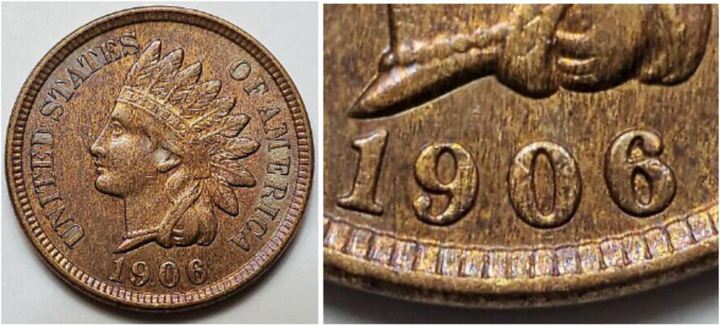
This is an Obverse repunched error, it occurs on the number “6” beneath Liberty’s head, if you look closely at the “6” you’ll see that it has a break, this is because it was repunched.
Clip Planchet Error
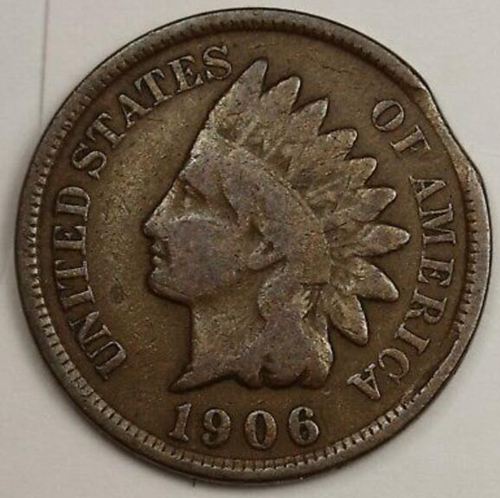
This clip error occurs at the right top of the coin. It’s a 2’o’ clock Obverse clip planchet error on an Indian Head coin.
Lamination error
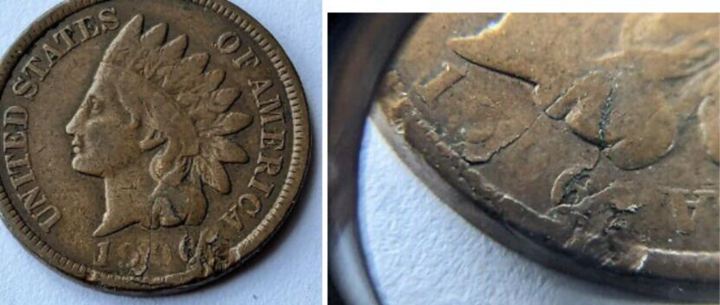
This lamination error occurs on the Obverse face of the coin, the crack occurs at Liberty’s neck and runs down to the rim of the coin even destroying the “1906” inscription.
Reverse Lamination Error
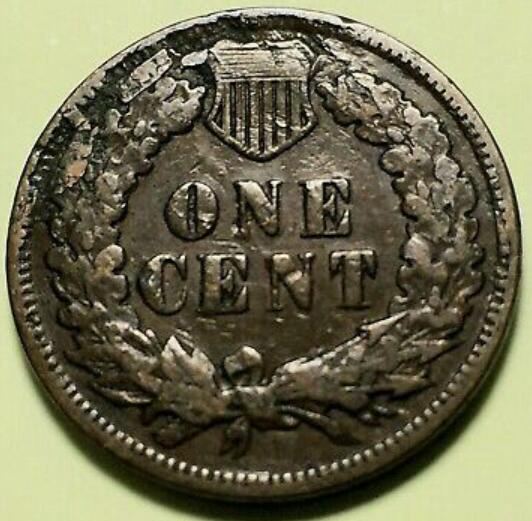
Here is another lamination error on the reverse face of this 1906 Indian Head coin. It occurs just above the shield of the coin.
Frequently Asked Questions
Why is there no mint mark on 1906 Indian Head penny?
All 1906 Indian Head Penny was produced only in the Philadelphia mint and as usual, this mint does not engrave any mintmarks.
Is the 1906 Indian Penny rare
This mintage of the 1906 Indian Penny coin is over 90,000,000. The low grades are still high in circulation, it is high-grade coins that are rare.
Does the 1906 Indian Head cents have Proofs?
Yes, the Proof version of this coin is available, and the Proof (PR63) cost about $160.
What are the 1906 Indian Penny Errors
The errors are mostly Planchet errors, including BroadStrikes, and Clip errors. Lamination errors and repunched letters are also available.
Summary
This coin is special for many reasons, the fact that it was the first American coin to be made of copper & nickel and also that it depicted the Native American culture through the headdress was indeed spectacular.
The 1906 Indian Head Penny is a collector’s delight. The most valuable are the higher grades such as MS 66 and MS 67. An MS 67 of this coin was sold for $27600 Heritage Auctions (01/05/2006). Regular grades are not worth much, just a few dollars.
